Monitoring Physical Exercise in COPD Patients: A Critical Assessment
VerifiedAdded on 2019/11/26
|14
|3898
|154
Report
AI Summary
Pulmonary rehabilitation is crucial for patients with chronic obstructive pulmonary disease (COPD). Susan Bennett, a patient with a history of intense smoking and depression, requires careful assessment to prescribe the right physical exercises. Avoiding heavy lifting, push-ups, isometric exercises, running, and other strenuous activities are essential to prevent exacerbations. Instead, aerobic exercise training can be effective in improving autonomic function and overall well-being.
Contribute Materials
Your contribution can guide someone’s learning journey. Share your
documents today.
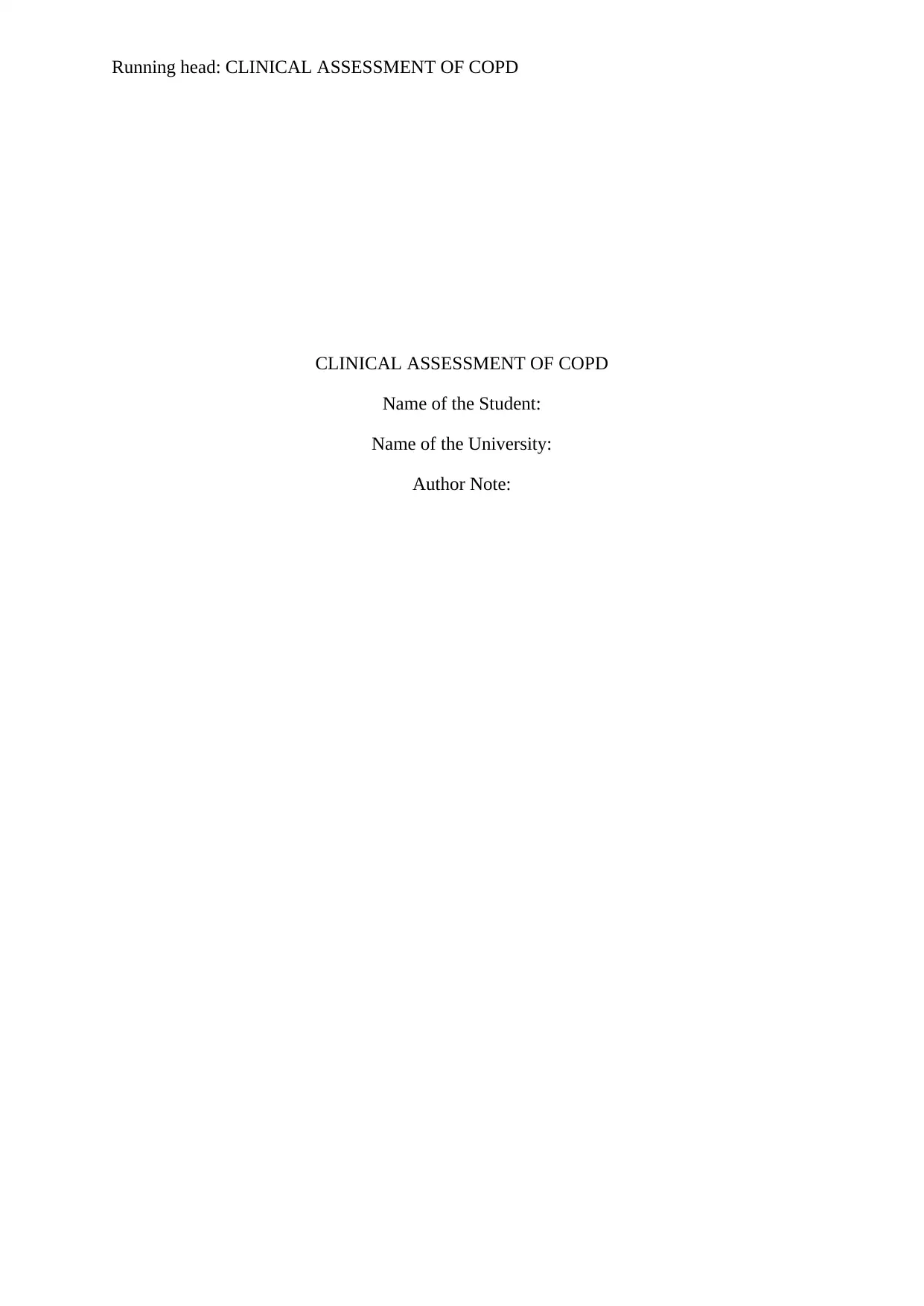
Running head: CLINICAL ASSESSMENT OF COPD
CLINICAL ASSESSMENT OF COPD
Name of the Student:
Name of the University:
Author Note:
CLINICAL ASSESSMENT OF COPD
Name of the Student:
Name of the University:
Author Note:
Secure Best Marks with AI Grader
Need help grading? Try our AI Grader for instant feedback on your assignments.
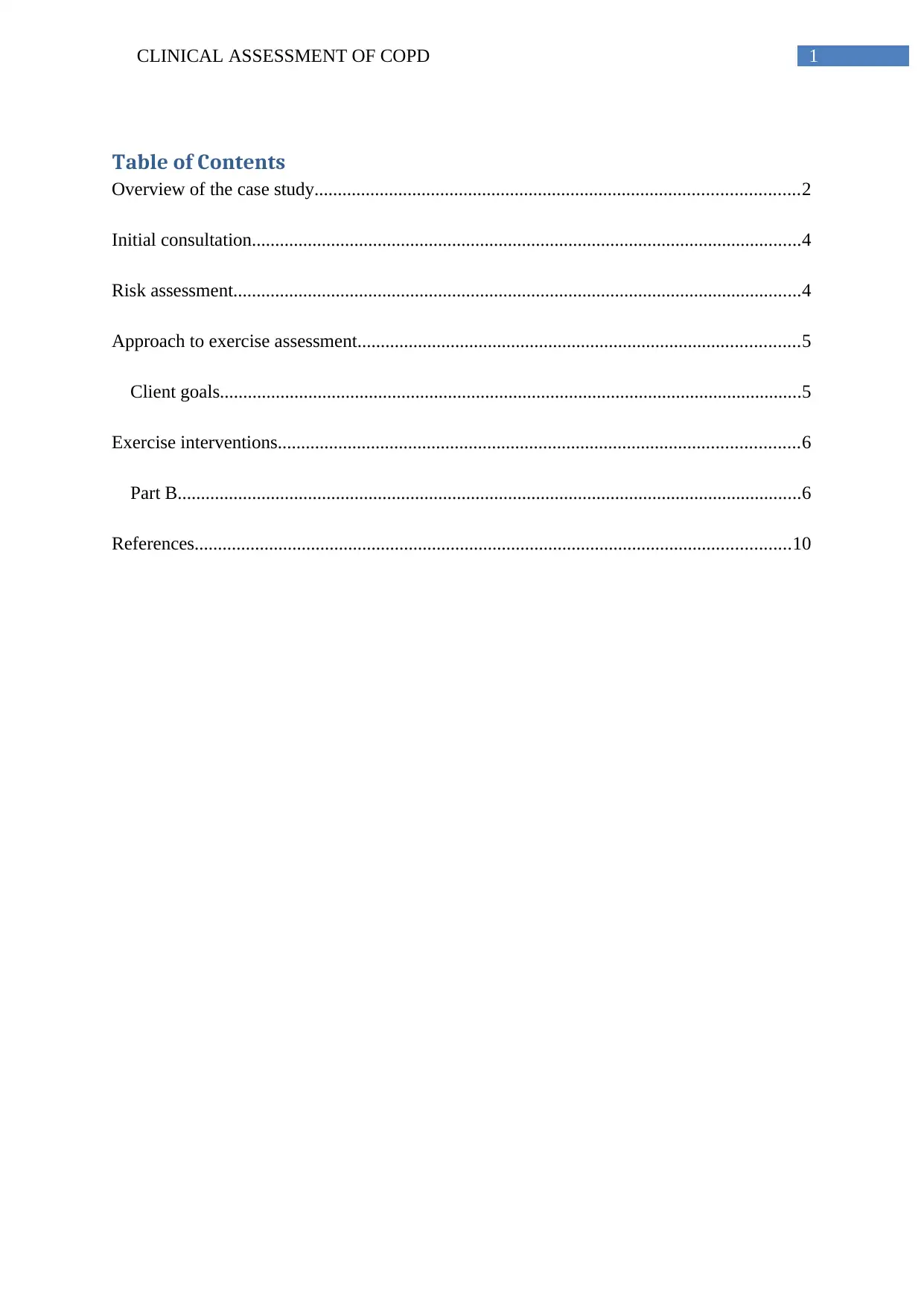
1CLINICAL ASSESSMENT OF COPD
Table of Contents
Overview of the case study........................................................................................................2
Initial consultation......................................................................................................................4
Risk assessment..........................................................................................................................4
Approach to exercise assessment...............................................................................................5
Client goals.............................................................................................................................5
Exercise interventions................................................................................................................6
Part B......................................................................................................................................6
References................................................................................................................................10
Table of Contents
Overview of the case study........................................................................................................2
Initial consultation......................................................................................................................4
Risk assessment..........................................................................................................................4
Approach to exercise assessment...............................................................................................5
Client goals.............................................................................................................................5
Exercise interventions................................................................................................................6
Part B......................................................................................................................................6
References................................................................................................................................10

2CLINICAL ASSESSMENT OF COPD
Overview of the case study
The seventy three year old retired Susan Bennett has been diagnosed with COPD.
COPD or chronic obstructive pulmonary disease is the disease of the lung that is
characterized by the chronic obstruction of the airflow to the lung. The normal breathing
mechanism is greatly influenced by it and the patient who is suffering from the COPD often
experiences shortness of breath which is increased gradually (Nordén et al., 2015). The client
is complaining her GP of her breathlessness even while carrying out her regular life activities.
Her GP interrogated her and came to know that she is also suffering from poor appetite and
could not eat. She has a history of smoking which she quitted a year back. The
pathophysiology of COPD is initiated with the airways and the air sac damage followed by
the cough and the difficulty in the breathing (Agustí et al., 2012).
An additional interrogation is carried out by the attending GP of Susan Bennett. She
complained of wheezing, frequent coughing which is sometimes accompanied by sputum and
tightness in the chest. She also complained that her coughing is getting severe and it is
making her difficult to eat. Her attending GP also observed that Susan has begun to lose
weight significantly and Susan also complained of her loss of appetite (Lainscak et al., 2016).
Her attending GP also examined that Susan is suffering from high blood pressure and that
may lead to the condition known as pulmonary hypertension.
COPD patients are often prescribed with exercises. Aerobic exercise is of much help
to the patients suffering from COPD as it helps to improve the tolerance of exercise
(Mohammed et al., 2017). They help to overcome the problem of breathlessness. Stretching
of the arms and legs in order to lengthen the arms slowly is an effective measure to improve
the motion and flexibility. Strengthening of the muscles by contracting the muscles
repeatedly is helpful as it strengthens the respiratory muscle.
Overview of the case study
The seventy three year old retired Susan Bennett has been diagnosed with COPD.
COPD or chronic obstructive pulmonary disease is the disease of the lung that is
characterized by the chronic obstruction of the airflow to the lung. The normal breathing
mechanism is greatly influenced by it and the patient who is suffering from the COPD often
experiences shortness of breath which is increased gradually (Nordén et al., 2015). The client
is complaining her GP of her breathlessness even while carrying out her regular life activities.
Her GP interrogated her and came to know that she is also suffering from poor appetite and
could not eat. She has a history of smoking which she quitted a year back. The
pathophysiology of COPD is initiated with the airways and the air sac damage followed by
the cough and the difficulty in the breathing (Agustí et al., 2012).
An additional interrogation is carried out by the attending GP of Susan Bennett. She
complained of wheezing, frequent coughing which is sometimes accompanied by sputum and
tightness in the chest. She also complained that her coughing is getting severe and it is
making her difficult to eat. Her attending GP also observed that Susan has begun to lose
weight significantly and Susan also complained of her loss of appetite (Lainscak et al., 2016).
Her attending GP also examined that Susan is suffering from high blood pressure and that
may lead to the condition known as pulmonary hypertension.
COPD patients are often prescribed with exercises. Aerobic exercise is of much help
to the patients suffering from COPD as it helps to improve the tolerance of exercise
(Mohammed et al., 2017). They help to overcome the problem of breathlessness. Stretching
of the arms and legs in order to lengthen the arms slowly is an effective measure to improve
the motion and flexibility. Strengthening of the muscles by contracting the muscles
repeatedly is helpful as it strengthens the respiratory muscle.
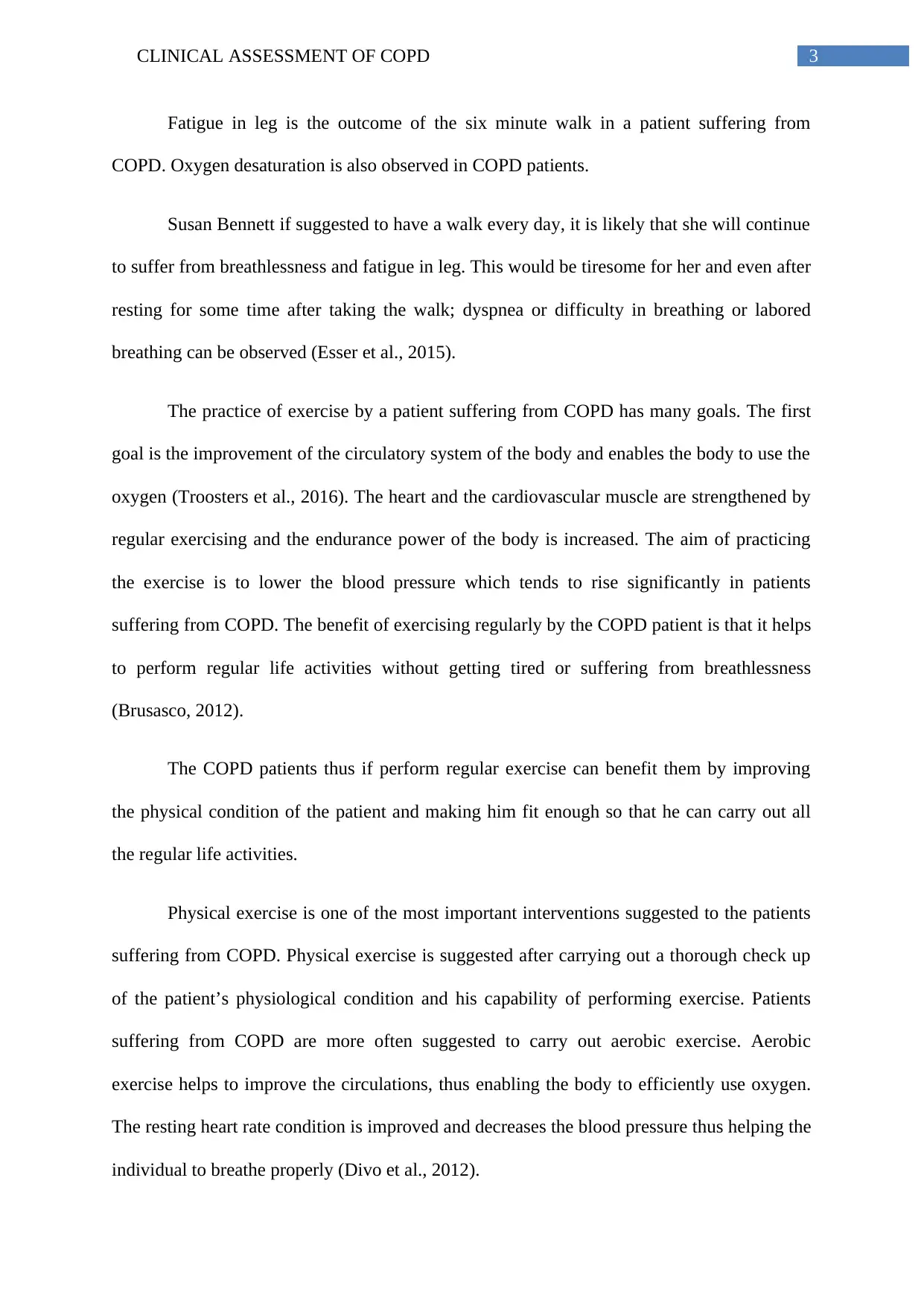
3CLINICAL ASSESSMENT OF COPD
Fatigue in leg is the outcome of the six minute walk in a patient suffering from
COPD. Oxygen desaturation is also observed in COPD patients.
Susan Bennett if suggested to have a walk every day, it is likely that she will continue
to suffer from breathlessness and fatigue in leg. This would be tiresome for her and even after
resting for some time after taking the walk; dyspnea or difficulty in breathing or labored
breathing can be observed (Esser et al., 2015).
The practice of exercise by a patient suffering from COPD has many goals. The first
goal is the improvement of the circulatory system of the body and enables the body to use the
oxygen (Troosters et al., 2016). The heart and the cardiovascular muscle are strengthened by
regular exercising and the endurance power of the body is increased. The aim of practicing
the exercise is to lower the blood pressure which tends to rise significantly in patients
suffering from COPD. The benefit of exercising regularly by the COPD patient is that it helps
to perform regular life activities without getting tired or suffering from breathlessness
(Brusasco, 2012).
The COPD patients thus if perform regular exercise can benefit them by improving
the physical condition of the patient and making him fit enough so that he can carry out all
the regular life activities.
Physical exercise is one of the most important interventions suggested to the patients
suffering from COPD. Physical exercise is suggested after carrying out a thorough check up
of the patient’s physiological condition and his capability of performing exercise. Patients
suffering from COPD are more often suggested to carry out aerobic exercise. Aerobic
exercise helps to improve the circulations, thus enabling the body to efficiently use oxygen.
The resting heart rate condition is improved and decreases the blood pressure thus helping the
individual to breathe properly (Divo et al., 2012).
Fatigue in leg is the outcome of the six minute walk in a patient suffering from
COPD. Oxygen desaturation is also observed in COPD patients.
Susan Bennett if suggested to have a walk every day, it is likely that she will continue
to suffer from breathlessness and fatigue in leg. This would be tiresome for her and even after
resting for some time after taking the walk; dyspnea or difficulty in breathing or labored
breathing can be observed (Esser et al., 2015).
The practice of exercise by a patient suffering from COPD has many goals. The first
goal is the improvement of the circulatory system of the body and enables the body to use the
oxygen (Troosters et al., 2016). The heart and the cardiovascular muscle are strengthened by
regular exercising and the endurance power of the body is increased. The aim of practicing
the exercise is to lower the blood pressure which tends to rise significantly in patients
suffering from COPD. The benefit of exercising regularly by the COPD patient is that it helps
to perform regular life activities without getting tired or suffering from breathlessness
(Brusasco, 2012).
The COPD patients thus if perform regular exercise can benefit them by improving
the physical condition of the patient and making him fit enough so that he can carry out all
the regular life activities.
Physical exercise is one of the most important interventions suggested to the patients
suffering from COPD. Physical exercise is suggested after carrying out a thorough check up
of the patient’s physiological condition and his capability of performing exercise. Patients
suffering from COPD are more often suggested to carry out aerobic exercise. Aerobic
exercise helps to improve the circulations, thus enabling the body to efficiently use oxygen.
The resting heart rate condition is improved and decreases the blood pressure thus helping the
individual to breathe properly (Divo et al., 2012).
Secure Best Marks with AI Grader
Need help grading? Try our AI Grader for instant feedback on your assignments.
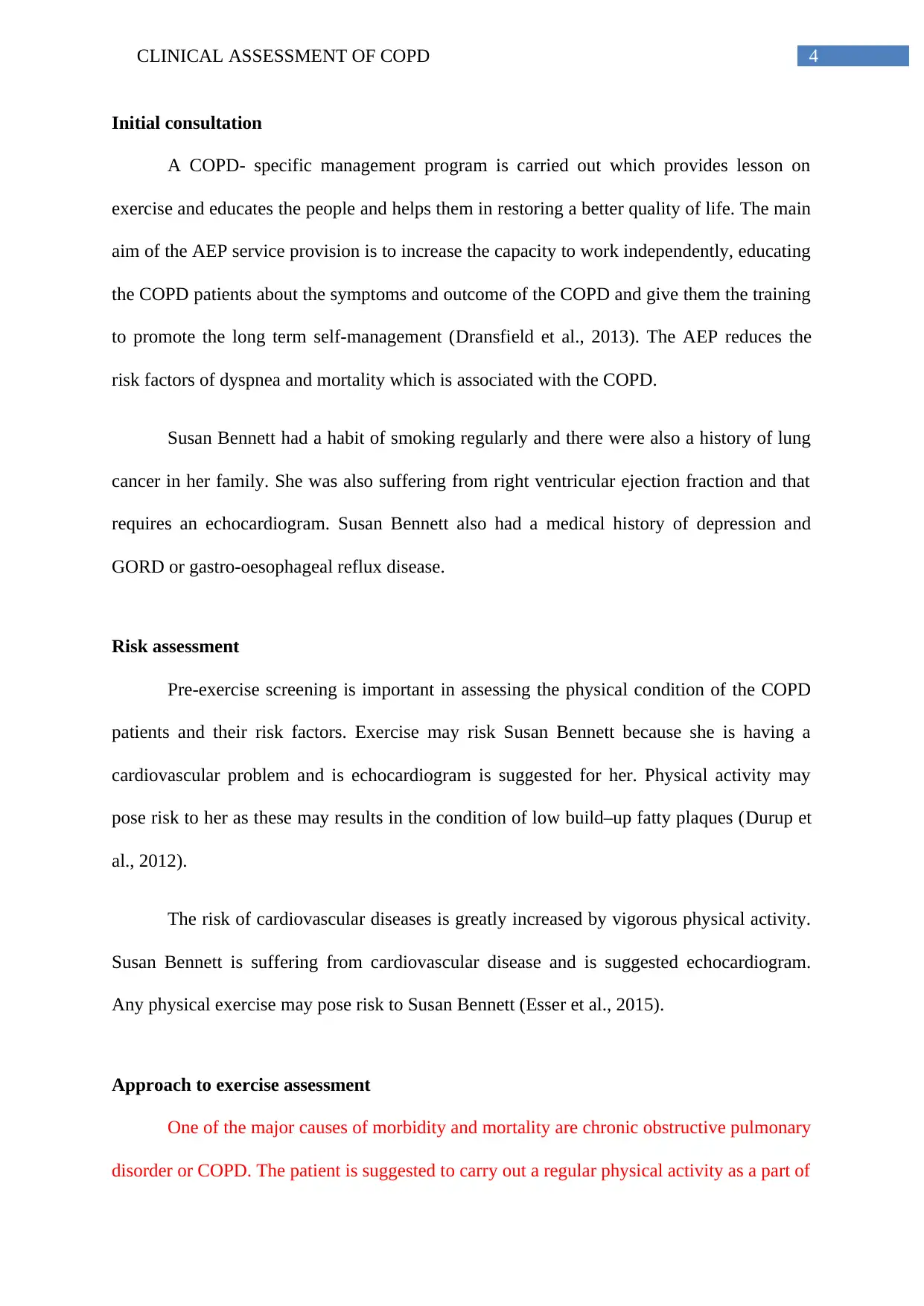
4CLINICAL ASSESSMENT OF COPD
Initial consultation
A COPD- specific management program is carried out which provides lesson on
exercise and educates the people and helps them in restoring a better quality of life. The main
aim of the AEP service provision is to increase the capacity to work independently, educating
the COPD patients about the symptoms and outcome of the COPD and give them the training
to promote the long term self-management (Dransfield et al., 2013). The AEP reduces the
risk factors of dyspnea and mortality which is associated with the COPD.
Susan Bennett had a habit of smoking regularly and there were also a history of lung
cancer in her family. She was also suffering from right ventricular ejection fraction and that
requires an echocardiogram. Susan Bennett also had a medical history of depression and
GORD or gastro-oesophageal reflux disease.
Risk assessment
Pre-exercise screening is important in assessing the physical condition of the COPD
patients and their risk factors. Exercise may risk Susan Bennett because she is having a
cardiovascular problem and is echocardiogram is suggested for her. Physical activity may
pose risk to her as these may results in the condition of low build–up fatty plaques (Durup et
al., 2012).
The risk of cardiovascular diseases is greatly increased by vigorous physical activity.
Susan Bennett is suffering from cardiovascular disease and is suggested echocardiogram.
Any physical exercise may pose risk to Susan Bennett (Esser et al., 2015).
Approach to exercise assessment
One of the major causes of morbidity and mortality are chronic obstructive pulmonary
disorder or COPD. The patient is suggested to carry out a regular physical activity as a part of
Initial consultation
A COPD- specific management program is carried out which provides lesson on
exercise and educates the people and helps them in restoring a better quality of life. The main
aim of the AEP service provision is to increase the capacity to work independently, educating
the COPD patients about the symptoms and outcome of the COPD and give them the training
to promote the long term self-management (Dransfield et al., 2013). The AEP reduces the
risk factors of dyspnea and mortality which is associated with the COPD.
Susan Bennett had a habit of smoking regularly and there were also a history of lung
cancer in her family. She was also suffering from right ventricular ejection fraction and that
requires an echocardiogram. Susan Bennett also had a medical history of depression and
GORD or gastro-oesophageal reflux disease.
Risk assessment
Pre-exercise screening is important in assessing the physical condition of the COPD
patients and their risk factors. Exercise may risk Susan Bennett because she is having a
cardiovascular problem and is echocardiogram is suggested for her. Physical activity may
pose risk to her as these may results in the condition of low build–up fatty plaques (Durup et
al., 2012).
The risk of cardiovascular diseases is greatly increased by vigorous physical activity.
Susan Bennett is suffering from cardiovascular disease and is suggested echocardiogram.
Any physical exercise may pose risk to Susan Bennett (Esser et al., 2015).
Approach to exercise assessment
One of the major causes of morbidity and mortality are chronic obstructive pulmonary
disorder or COPD. The patient is suggested to carry out a regular physical activity as a part of

5CLINICAL ASSESSMENT OF COPD
the treatment. The exercise assessment is mainly done by the pulmonary rehabilitation which
includes the supervision of the exercise training, psychological support o the COPD patients,
a self-management education and a counseling process. The patients are meant to attend this
session that would help to assess the exercise outcomes that they are undergoing. The
assessments also includes the study and understanding of the patient’s medical history, the
examination of the current breathing condition of the patient and identification of other
limitations that may interfere with the rehabilitation process.
The nutritional assessment of the patient is also carried out which becomes a part of
the rehabilitation process.
Client goals
Susan Bennett was prescribed to do vigorous exercise after a pre-exercise screening
was conducted. The goal of prescribing the physical activity is the improvement of the
circulation and the COPD symptoms. The goal of the physical activity is to strengthen the
cardiovascular system and help Susan Bennett to increase her power to endure. It also aims to
lower the blood pressure that tends to increase in the patients suffering from COPD. Another
most important goal of the physical exercise is that it helps to improve the oxygen utilization
by the body (Galbán et al., 2012).
Stretching exercise would help Susan Bennett to increase her flexibility as it involves
the heart and lungs and thus in turn help to improve the endurance. Susan Bennett would get
help if she performs aerobic exercise as it would help her to increase the endurance level of
the heart and the muscle (Gloeckl, Marinov & Pitta, 2013). Thus, one of the goals of the
exercise intervention is met. The aerobic exercise would also help the body to use the oxygen
efficiently which gradually increase the breathing capacity of Susan Bennett.
the treatment. The exercise assessment is mainly done by the pulmonary rehabilitation which
includes the supervision of the exercise training, psychological support o the COPD patients,
a self-management education and a counseling process. The patients are meant to attend this
session that would help to assess the exercise outcomes that they are undergoing. The
assessments also includes the study and understanding of the patient’s medical history, the
examination of the current breathing condition of the patient and identification of other
limitations that may interfere with the rehabilitation process.
The nutritional assessment of the patient is also carried out which becomes a part of
the rehabilitation process.
Client goals
Susan Bennett was prescribed to do vigorous exercise after a pre-exercise screening
was conducted. The goal of prescribing the physical activity is the improvement of the
circulation and the COPD symptoms. The goal of the physical activity is to strengthen the
cardiovascular system and help Susan Bennett to increase her power to endure. It also aims to
lower the blood pressure that tends to increase in the patients suffering from COPD. Another
most important goal of the physical exercise is that it helps to improve the oxygen utilization
by the body (Galbán et al., 2012).
Stretching exercise would help Susan Bennett to increase her flexibility as it involves
the heart and lungs and thus in turn help to improve the endurance. Susan Bennett would get
help if she performs aerobic exercise as it would help her to increase the endurance level of
the heart and the muscle (Gloeckl, Marinov & Pitta, 2013). Thus, one of the goals of the
exercise intervention is met. The aerobic exercise would also help the body to use the oxygen
efficiently which gradually increase the breathing capacity of Susan Bennett.
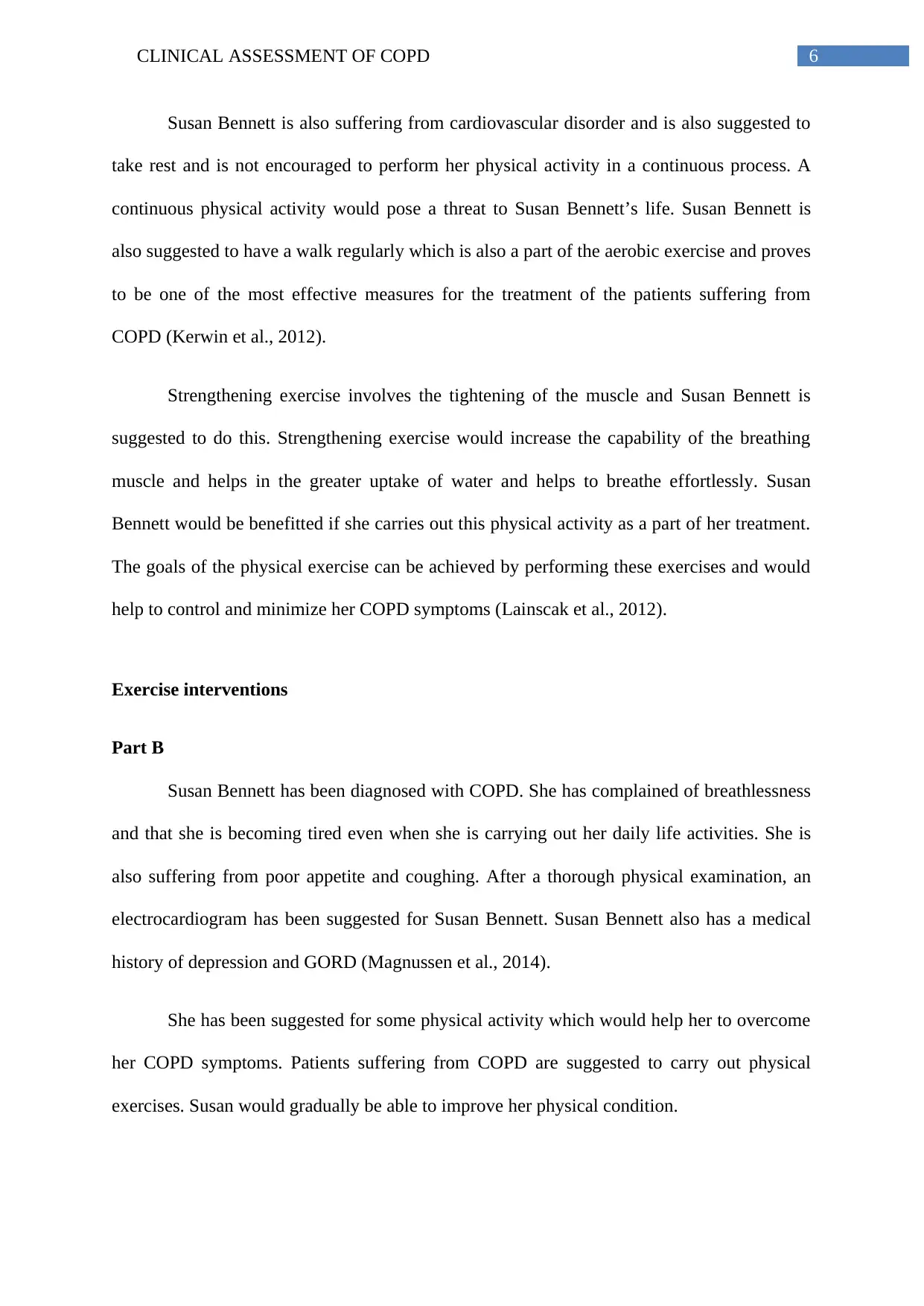
6CLINICAL ASSESSMENT OF COPD
Susan Bennett is also suffering from cardiovascular disorder and is also suggested to
take rest and is not encouraged to perform her physical activity in a continuous process. A
continuous physical activity would pose a threat to Susan Bennett’s life. Susan Bennett is
also suggested to have a walk regularly which is also a part of the aerobic exercise and proves
to be one of the most effective measures for the treatment of the patients suffering from
COPD (Kerwin et al., 2012).
Strengthening exercise involves the tightening of the muscle and Susan Bennett is
suggested to do this. Strengthening exercise would increase the capability of the breathing
muscle and helps in the greater uptake of water and helps to breathe effortlessly. Susan
Bennett would be benefitted if she carries out this physical activity as a part of her treatment.
The goals of the physical exercise can be achieved by performing these exercises and would
help to control and minimize her COPD symptoms (Lainscak et al., 2012).
Exercise interventions
Part B
Susan Bennett has been diagnosed with COPD. She has complained of breathlessness
and that she is becoming tired even when she is carrying out her daily life activities. She is
also suffering from poor appetite and coughing. After a thorough physical examination, an
electrocardiogram has been suggested for Susan Bennett. Susan Bennett also has a medical
history of depression and GORD (Magnussen et al., 2014).
She has been suggested for some physical activity which would help her to overcome
her COPD symptoms. Patients suffering from COPD are suggested to carry out physical
exercises. Susan would gradually be able to improve her physical condition.
Susan Bennett is also suffering from cardiovascular disorder and is also suggested to
take rest and is not encouraged to perform her physical activity in a continuous process. A
continuous physical activity would pose a threat to Susan Bennett’s life. Susan Bennett is
also suggested to have a walk regularly which is also a part of the aerobic exercise and proves
to be one of the most effective measures for the treatment of the patients suffering from
COPD (Kerwin et al., 2012).
Strengthening exercise involves the tightening of the muscle and Susan Bennett is
suggested to do this. Strengthening exercise would increase the capability of the breathing
muscle and helps in the greater uptake of water and helps to breathe effortlessly. Susan
Bennett would be benefitted if she carries out this physical activity as a part of her treatment.
The goals of the physical exercise can be achieved by performing these exercises and would
help to control and minimize her COPD symptoms (Lainscak et al., 2012).
Exercise interventions
Part B
Susan Bennett has been diagnosed with COPD. She has complained of breathlessness
and that she is becoming tired even when she is carrying out her daily life activities. She is
also suffering from poor appetite and coughing. After a thorough physical examination, an
electrocardiogram has been suggested for Susan Bennett. Susan Bennett also has a medical
history of depression and GORD (Magnussen et al., 2014).
She has been suggested for some physical activity which would help her to overcome
her COPD symptoms. Patients suffering from COPD are suggested to carry out physical
exercises. Susan would gradually be able to improve her physical condition.
Paraphrase This Document
Need a fresh take? Get an instant paraphrase of this document with our AI Paraphraser

7CLINICAL ASSESSMENT OF COPD
Exercise training can greatly increase the quality of life in relation to health of the
patient and enhance the exercise tolerance by the patient suffering from COPD. Susan
Bennett has a history of depression and pulmonary rehabilitation would be of much help to
her. Pulmonary rehabilitation is a treatment procedure of the COPD patient that includes the
psychological counseling and exercising training for the COPD patients (Menezes et al.,
2014). It is one of the most important parts of the treatment of the COPD patient and becomes
a significant management programs that is carried out to control the chronic obstructive
pulmonary disorder.
Susan must consult with her physician before she starts her physical exercise in order
to undergo a thorough a check up of her physiological condition. Her physician must consult
with her to set the goals to enhance her body fitness and enables her to breathe effortlessly.
They should discuss if there is any risk factors of her doing the physical exercise. It is the
duty of the physician to inform Susan Bennett that she should adjust the amount of physical
exercise she should carry out according to her physiological condition (Mohammed et al.,
2017).
Stretching exercises is one of the best options available for the COPD patients; it
helps in lengthening the muscles of the patients and increases their flexibility as well, these
aerobic exercises are known to increase the endurance and functionality of the heart and
lungs and are known to be extremely beneficial for the COPD patients. Aerobic exercises
increase the capability of oxygen saturation of your body allowing you to use more of the
oxygen consumed and improves the breathing as well. Walking and using stationary bikes are
other alternatives applicable for COPD patients to try as well (Nordén et al., 2015).
Pursed lip breathing is another highly effective breathing exercise for the COPD
patients, this exercise is advised by respiratory disease experts to utilize while doing other
Exercise training can greatly increase the quality of life in relation to health of the
patient and enhance the exercise tolerance by the patient suffering from COPD. Susan
Bennett has a history of depression and pulmonary rehabilitation would be of much help to
her. Pulmonary rehabilitation is a treatment procedure of the COPD patient that includes the
psychological counseling and exercising training for the COPD patients (Menezes et al.,
2014). It is one of the most important parts of the treatment of the COPD patient and becomes
a significant management programs that is carried out to control the chronic obstructive
pulmonary disorder.
Susan must consult with her physician before she starts her physical exercise in order
to undergo a thorough a check up of her physiological condition. Her physician must consult
with her to set the goals to enhance her body fitness and enables her to breathe effortlessly.
They should discuss if there is any risk factors of her doing the physical exercise. It is the
duty of the physician to inform Susan Bennett that she should adjust the amount of physical
exercise she should carry out according to her physiological condition (Mohammed et al.,
2017).
Stretching exercises is one of the best options available for the COPD patients; it
helps in lengthening the muscles of the patients and increases their flexibility as well, these
aerobic exercises are known to increase the endurance and functionality of the heart and
lungs and are known to be extremely beneficial for the COPD patients. Aerobic exercises
increase the capability of oxygen saturation of your body allowing you to use more of the
oxygen consumed and improves the breathing as well. Walking and using stationary bikes are
other alternatives applicable for COPD patients to try as well (Nordén et al., 2015).
Pursed lip breathing is another highly effective breathing exercise for the COPD
patients, this exercise is advised by respiratory disease experts to utilize while doing other
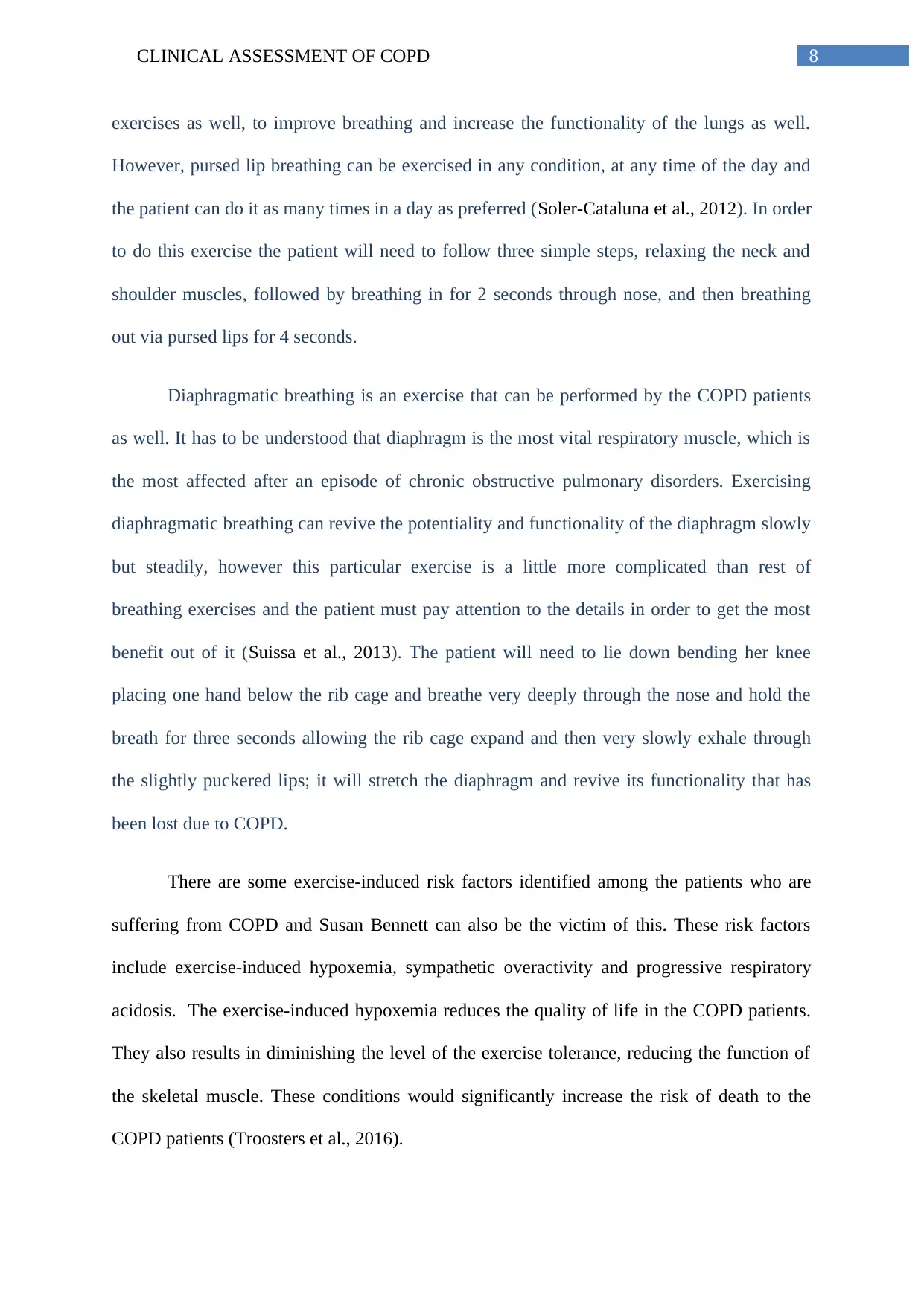
8CLINICAL ASSESSMENT OF COPD
exercises as well, to improve breathing and increase the functionality of the lungs as well.
However, pursed lip breathing can be exercised in any condition, at any time of the day and
the patient can do it as many times in a day as preferred (Soler-Cataluna et al., 2012). In order
to do this exercise the patient will need to follow three simple steps, relaxing the neck and
shoulder muscles, followed by breathing in for 2 seconds through nose, and then breathing
out via pursed lips for 4 seconds.
Diaphragmatic breathing is an exercise that can be performed by the COPD patients
as well. It has to be understood that diaphragm is the most vital respiratory muscle, which is
the most affected after an episode of chronic obstructive pulmonary disorders. Exercising
diaphragmatic breathing can revive the potentiality and functionality of the diaphragm slowly
but steadily, however this particular exercise is a little more complicated than rest of
breathing exercises and the patient must pay attention to the details in order to get the most
benefit out of it (Suissa et al., 2013). The patient will need to lie down bending her knee
placing one hand below the rib cage and breathe very deeply through the nose and hold the
breath for three seconds allowing the rib cage expand and then very slowly exhale through
the slightly puckered lips; it will stretch the diaphragm and revive its functionality that has
been lost due to COPD.
There are some exercise-induced risk factors identified among the patients who are
suffering from COPD and Susan Bennett can also be the victim of this. These risk factors
include exercise-induced hypoxemia, sympathetic overactivity and progressive respiratory
acidosis. The exercise-induced hypoxemia reduces the quality of life in the COPD patients.
They also results in diminishing the level of the exercise tolerance, reducing the function of
the skeletal muscle. These conditions would significantly increase the risk of death to the
COPD patients (Troosters et al., 2016).
exercises as well, to improve breathing and increase the functionality of the lungs as well.
However, pursed lip breathing can be exercised in any condition, at any time of the day and
the patient can do it as many times in a day as preferred (Soler-Cataluna et al., 2012). In order
to do this exercise the patient will need to follow three simple steps, relaxing the neck and
shoulder muscles, followed by breathing in for 2 seconds through nose, and then breathing
out via pursed lips for 4 seconds.
Diaphragmatic breathing is an exercise that can be performed by the COPD patients
as well. It has to be understood that diaphragm is the most vital respiratory muscle, which is
the most affected after an episode of chronic obstructive pulmonary disorders. Exercising
diaphragmatic breathing can revive the potentiality and functionality of the diaphragm slowly
but steadily, however this particular exercise is a little more complicated than rest of
breathing exercises and the patient must pay attention to the details in order to get the most
benefit out of it (Suissa et al., 2013). The patient will need to lie down bending her knee
placing one hand below the rib cage and breathe very deeply through the nose and hold the
breath for three seconds allowing the rib cage expand and then very slowly exhale through
the slightly puckered lips; it will stretch the diaphragm and revive its functionality that has
been lost due to COPD.
There are some exercise-induced risk factors identified among the patients who are
suffering from COPD and Susan Bennett can also be the victim of this. These risk factors
include exercise-induced hypoxemia, sympathetic overactivity and progressive respiratory
acidosis. The exercise-induced hypoxemia reduces the quality of life in the COPD patients.
They also results in diminishing the level of the exercise tolerance, reducing the function of
the skeletal muscle. These conditions would significantly increase the risk of death to the
COPD patients (Troosters et al., 2016).
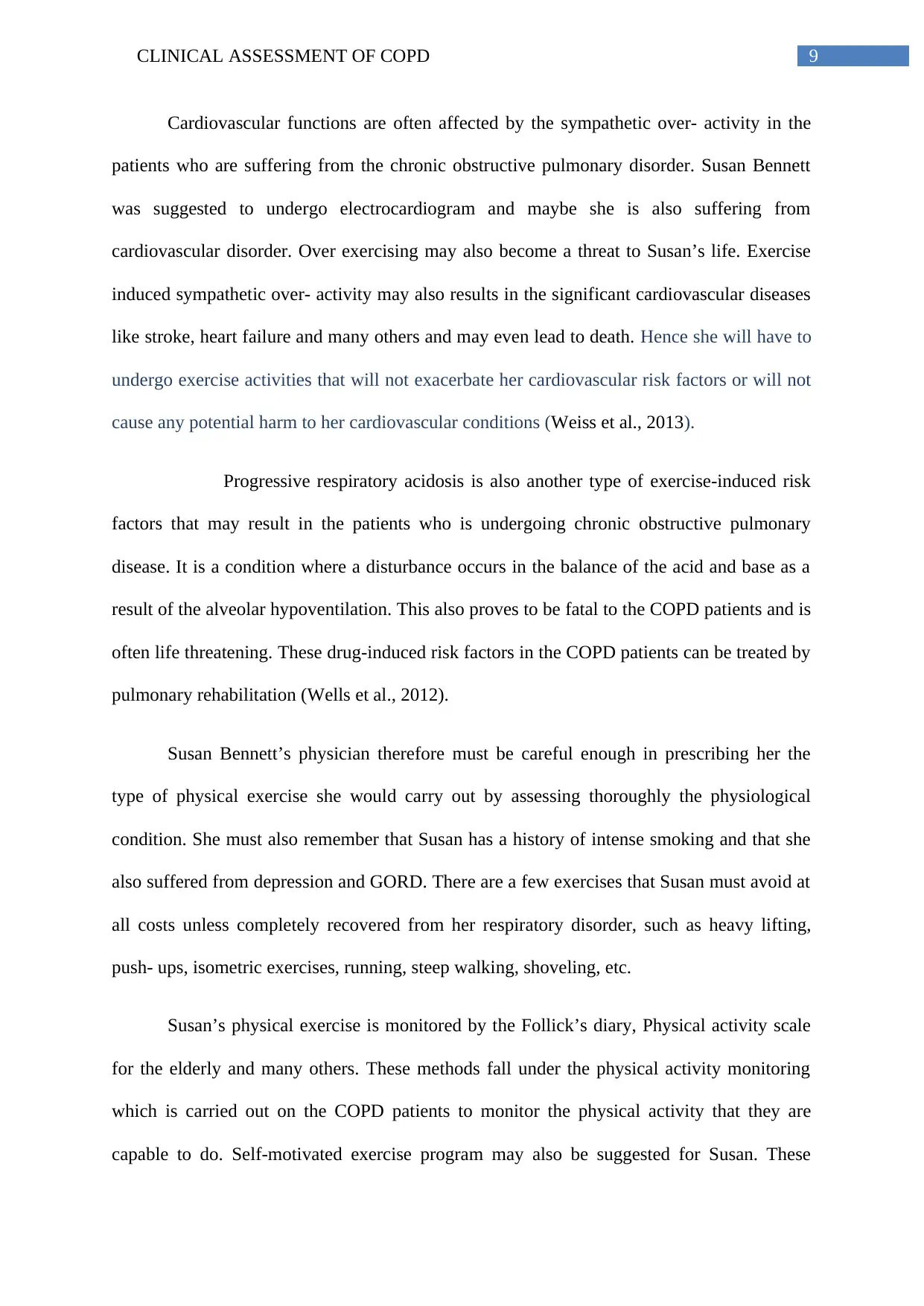
9CLINICAL ASSESSMENT OF COPD
Cardiovascular functions are often affected by the sympathetic over- activity in the
patients who are suffering from the chronic obstructive pulmonary disorder. Susan Bennett
was suggested to undergo electrocardiogram and maybe she is also suffering from
cardiovascular disorder. Over exercising may also become a threat to Susan’s life. Exercise
induced sympathetic over- activity may also results in the significant cardiovascular diseases
like stroke, heart failure and many others and may even lead to death. Hence she will have to
undergo exercise activities that will not exacerbate her cardiovascular risk factors or will not
cause any potential harm to her cardiovascular conditions (Weiss et al., 2013).
Progressive respiratory acidosis is also another type of exercise-induced risk
factors that may result in the patients who is undergoing chronic obstructive pulmonary
disease. It is a condition where a disturbance occurs in the balance of the acid and base as a
result of the alveolar hypoventilation. This also proves to be fatal to the COPD patients and is
often life threatening. These drug-induced risk factors in the COPD patients can be treated by
pulmonary rehabilitation (Wells et al., 2012).
Susan Bennett’s physician therefore must be careful enough in prescribing her the
type of physical exercise she would carry out by assessing thoroughly the physiological
condition. She must also remember that Susan has a history of intense smoking and that she
also suffered from depression and GORD. There are a few exercises that Susan must avoid at
all costs unless completely recovered from her respiratory disorder, such as heavy lifting,
push- ups, isometric exercises, running, steep walking, shoveling, etc.
Susan’s physical exercise is monitored by the Follick’s diary, Physical activity scale
for the elderly and many others. These methods fall under the physical activity monitoring
which is carried out on the COPD patients to monitor the physical activity that they are
capable to do. Self-motivated exercise program may also be suggested for Susan. These
Cardiovascular functions are often affected by the sympathetic over- activity in the
patients who are suffering from the chronic obstructive pulmonary disorder. Susan Bennett
was suggested to undergo electrocardiogram and maybe she is also suffering from
cardiovascular disorder. Over exercising may also become a threat to Susan’s life. Exercise
induced sympathetic over- activity may also results in the significant cardiovascular diseases
like stroke, heart failure and many others and may even lead to death. Hence she will have to
undergo exercise activities that will not exacerbate her cardiovascular risk factors or will not
cause any potential harm to her cardiovascular conditions (Weiss et al., 2013).
Progressive respiratory acidosis is also another type of exercise-induced risk
factors that may result in the patients who is undergoing chronic obstructive pulmonary
disease. It is a condition where a disturbance occurs in the balance of the acid and base as a
result of the alveolar hypoventilation. This also proves to be fatal to the COPD patients and is
often life threatening. These drug-induced risk factors in the COPD patients can be treated by
pulmonary rehabilitation (Wells et al., 2012).
Susan Bennett’s physician therefore must be careful enough in prescribing her the
type of physical exercise she would carry out by assessing thoroughly the physiological
condition. She must also remember that Susan has a history of intense smoking and that she
also suffered from depression and GORD. There are a few exercises that Susan must avoid at
all costs unless completely recovered from her respiratory disorder, such as heavy lifting,
push- ups, isometric exercises, running, steep walking, shoveling, etc.
Susan’s physical exercise is monitored by the Follick’s diary, Physical activity scale
for the elderly and many others. These methods fall under the physical activity monitoring
which is carried out on the COPD patients to monitor the physical activity that they are
capable to do. Self-motivated exercise program may also be suggested for Susan. These
Secure Best Marks with AI Grader
Need help grading? Try our AI Grader for instant feedback on your assignments.

10CLINICAL ASSESSMENT OF COPD
monitoring techniques are affordable and effective to monitor the physical activities that
Susan will carry out as a part of treatment for COPD (Boerrigter et al., 2012).
monitoring techniques are affordable and effective to monitor the physical activities that
Susan will carry out as a part of treatment for COPD (Boerrigter et al., 2012).

11CLINICAL ASSESSMENT OF COPD
References
Agustí, A., Edwards, L. D., Rennard, S. I., MacNee, W., Tal-Singer, R., Miller, B. E., ... &
Crim, C. (2012). Persistent systemic inflammation is associated with poor clinical
outcomes in COPD: a novel phenotype. PloS one, 7(5), e37483.
Boerrigter, B. G., Bogaard, H. J., Trip, P., Groepenhoff, H., Rietema, H., Holverda, S., ... &
Vonk-Noordegraaf, A. (2012). Ventilatory and cardiocirculatory exercise profiles in
COPD: the role of pulmonary hypertension. CHEST Journal, 142(5), 1166-1174.
Brusasco, V. (2012). Spirometric definition of COPD: exercise in futility or factual debate?.
Divo, M., Cote, C., de Torres, J. P., Casanova, C., Marin, J. M., Pinto-Plata, V., ... & Celli, B.
(2012). Comorbidities and risk of mortality in patients with chronic obstructive
pulmonary disease. American journal of respiratory and critical care
medicine, 186(2), 155-161.
Dransfield, M. T., Bourbeau, J., Jones, P. W., Hanania, N. A., Mahler, D. A., Vestbo, J., ... &
Lettis, S. (2013). Once-daily inhaled fluticasone furoate and vilanterol versus
vilanterol only for prevention of exacerbations of COPD: two replicate double-blind,
parallel-group, randomised controlled trials. The Lancet Respiratory Medicine, 1(3),
210-223.
Durup, D. J. H. C. J. S. P. H. A. L. B., Jørgensen, H. L., Christensen, J., Schwarz, P.,
Heegaard, A. M., & Lind, B. (2012). A reverse J-shaped association of all-cause
mortality with serum 25-hydroxyvitamin D in general practice: the CopD study. The
Journal of Clinical Endocrinology & Metabolism, 97(8), 2644-2652.
References
Agustí, A., Edwards, L. D., Rennard, S. I., MacNee, W., Tal-Singer, R., Miller, B. E., ... &
Crim, C. (2012). Persistent systemic inflammation is associated with poor clinical
outcomes in COPD: a novel phenotype. PloS one, 7(5), e37483.
Boerrigter, B. G., Bogaard, H. J., Trip, P., Groepenhoff, H., Rietema, H., Holverda, S., ... &
Vonk-Noordegraaf, A. (2012). Ventilatory and cardiocirculatory exercise profiles in
COPD: the role of pulmonary hypertension. CHEST Journal, 142(5), 1166-1174.
Brusasco, V. (2012). Spirometric definition of COPD: exercise in futility or factual debate?.
Divo, M., Cote, C., de Torres, J. P., Casanova, C., Marin, J. M., Pinto-Plata, V., ... & Celli, B.
(2012). Comorbidities and risk of mortality in patients with chronic obstructive
pulmonary disease. American journal of respiratory and critical care
medicine, 186(2), 155-161.
Dransfield, M. T., Bourbeau, J., Jones, P. W., Hanania, N. A., Mahler, D. A., Vestbo, J., ... &
Lettis, S. (2013). Once-daily inhaled fluticasone furoate and vilanterol versus
vilanterol only for prevention of exacerbations of COPD: two replicate double-blind,
parallel-group, randomised controlled trials. The Lancet Respiratory Medicine, 1(3),
210-223.
Durup, D. J. H. C. J. S. P. H. A. L. B., Jørgensen, H. L., Christensen, J., Schwarz, P.,
Heegaard, A. M., & Lind, B. (2012). A reverse J-shaped association of all-cause
mortality with serum 25-hydroxyvitamin D in general practice: the CopD study. The
Journal of Clinical Endocrinology & Metabolism, 97(8), 2644-2652.
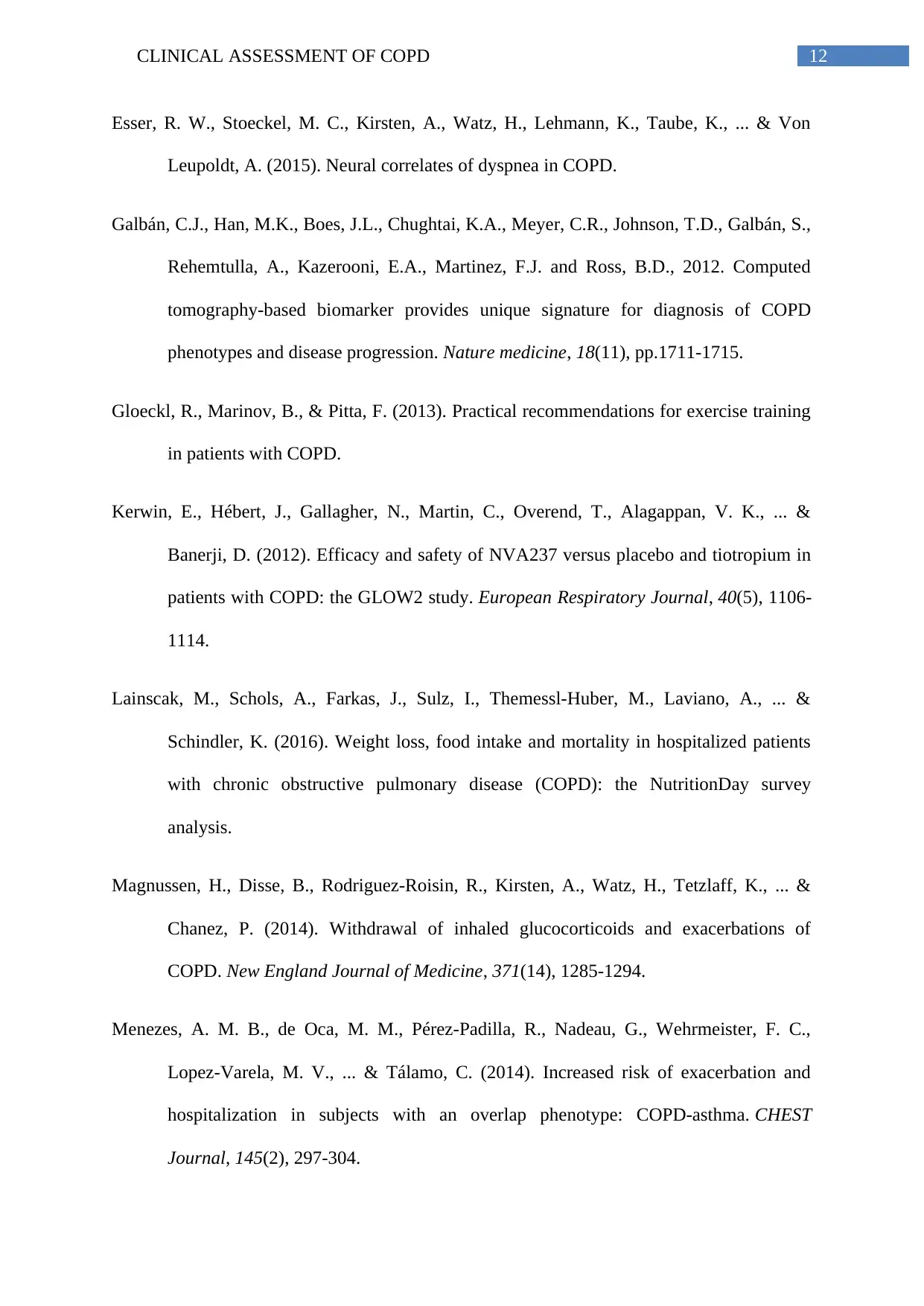
12CLINICAL ASSESSMENT OF COPD
Esser, R. W., Stoeckel, M. C., Kirsten, A., Watz, H., Lehmann, K., Taube, K., ... & Von
Leupoldt, A. (2015). Neural correlates of dyspnea in COPD.
Galbán, C.J., Han, M.K., Boes, J.L., Chughtai, K.A., Meyer, C.R., Johnson, T.D., Galbán, S.,
Rehemtulla, A., Kazerooni, E.A., Martinez, F.J. and Ross, B.D., 2012. Computed
tomography-based biomarker provides unique signature for diagnosis of COPD
phenotypes and disease progression. Nature medicine, 18(11), pp.1711-1715.
Gloeckl, R., Marinov, B., & Pitta, F. (2013). Practical recommendations for exercise training
in patients with COPD.
Kerwin, E., Hébert, J., Gallagher, N., Martin, C., Overend, T., Alagappan, V. K., ... &
Banerji, D. (2012). Efficacy and safety of NVA237 versus placebo and tiotropium in
patients with COPD: the GLOW2 study. European Respiratory Journal, 40(5), 1106-
1114.
Lainscak, M., Schols, A., Farkas, J., Sulz, I., Themessl-Huber, M., Laviano, A., ... &
Schindler, K. (2016). Weight loss, food intake and mortality in hospitalized patients
with chronic obstructive pulmonary disease (COPD): the NutritionDay survey
analysis.
Magnussen, H., Disse, B., Rodriguez-Roisin, R., Kirsten, A., Watz, H., Tetzlaff, K., ... &
Chanez, P. (2014). Withdrawal of inhaled glucocorticoids and exacerbations of
COPD. New England Journal of Medicine, 371(14), 1285-1294.
Menezes, A. M. B., de Oca, M. M., Pérez-Padilla, R., Nadeau, G., Wehrmeister, F. C.,
Lopez-Varela, M. V., ... & Tálamo, C. (2014). Increased risk of exacerbation and
hospitalization in subjects with an overlap phenotype: COPD-asthma. CHEST
Journal, 145(2), 297-304.
Esser, R. W., Stoeckel, M. C., Kirsten, A., Watz, H., Lehmann, K., Taube, K., ... & Von
Leupoldt, A. (2015). Neural correlates of dyspnea in COPD.
Galbán, C.J., Han, M.K., Boes, J.L., Chughtai, K.A., Meyer, C.R., Johnson, T.D., Galbán, S.,
Rehemtulla, A., Kazerooni, E.A., Martinez, F.J. and Ross, B.D., 2012. Computed
tomography-based biomarker provides unique signature for diagnosis of COPD
phenotypes and disease progression. Nature medicine, 18(11), pp.1711-1715.
Gloeckl, R., Marinov, B., & Pitta, F. (2013). Practical recommendations for exercise training
in patients with COPD.
Kerwin, E., Hébert, J., Gallagher, N., Martin, C., Overend, T., Alagappan, V. K., ... &
Banerji, D. (2012). Efficacy and safety of NVA237 versus placebo and tiotropium in
patients with COPD: the GLOW2 study. European Respiratory Journal, 40(5), 1106-
1114.
Lainscak, M., Schols, A., Farkas, J., Sulz, I., Themessl-Huber, M., Laviano, A., ... &
Schindler, K. (2016). Weight loss, food intake and mortality in hospitalized patients
with chronic obstructive pulmonary disease (COPD): the NutritionDay survey
analysis.
Magnussen, H., Disse, B., Rodriguez-Roisin, R., Kirsten, A., Watz, H., Tetzlaff, K., ... &
Chanez, P. (2014). Withdrawal of inhaled glucocorticoids and exacerbations of
COPD. New England Journal of Medicine, 371(14), 1285-1294.
Menezes, A. M. B., de Oca, M. M., Pérez-Padilla, R., Nadeau, G., Wehrmeister, F. C.,
Lopez-Varela, M. V., ... & Tálamo, C. (2014). Increased risk of exacerbation and
hospitalization in subjects with an overlap phenotype: COPD-asthma. CHEST
Journal, 145(2), 297-304.
Paraphrase This Document
Need a fresh take? Get an instant paraphrase of this document with our AI Paraphraser
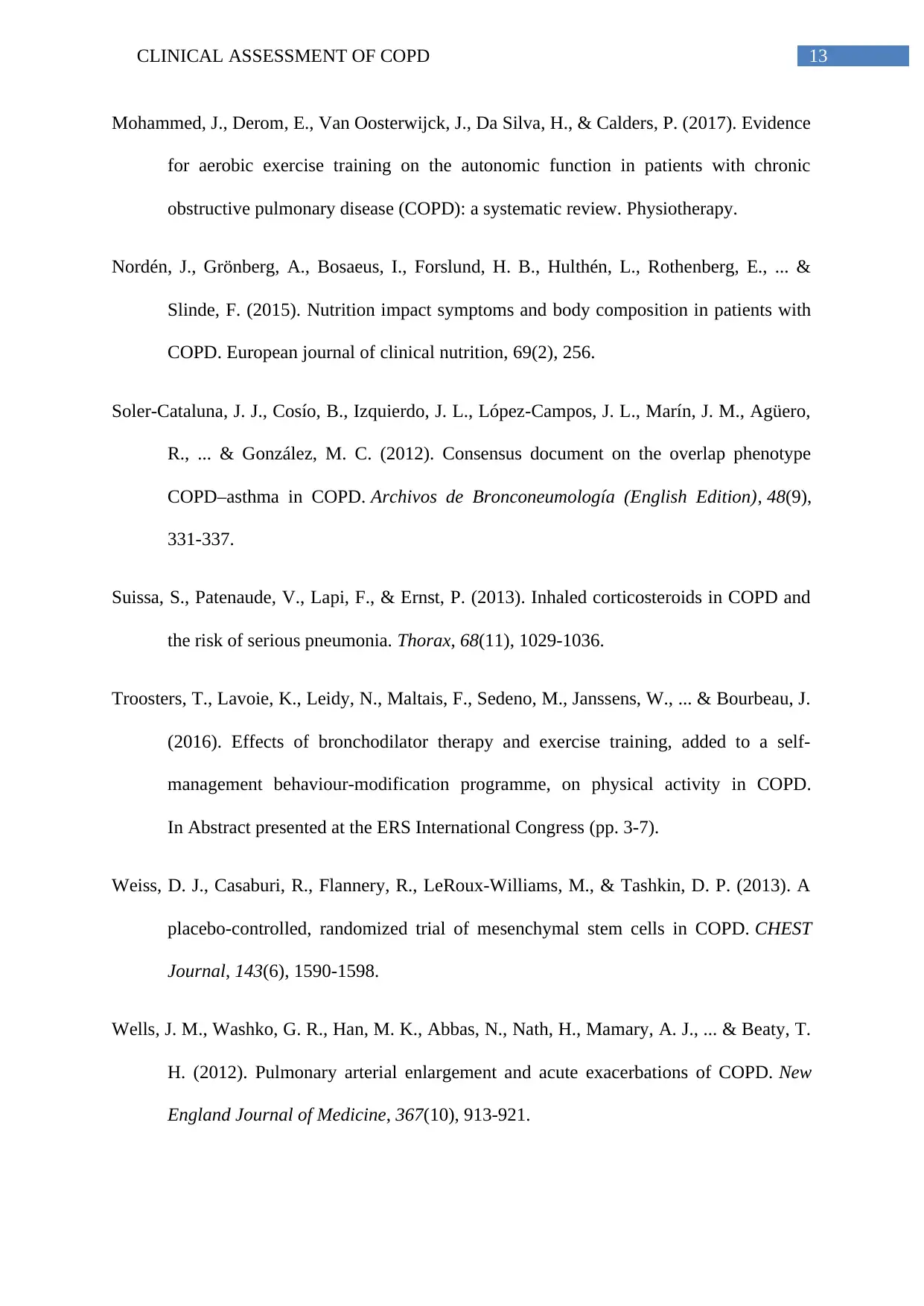
13CLINICAL ASSESSMENT OF COPD
Mohammed, J., Derom, E., Van Oosterwijck, J., Da Silva, H., & Calders, P. (2017). Evidence
for aerobic exercise training on the autonomic function in patients with chronic
obstructive pulmonary disease (COPD): a systematic review. Physiotherapy.
Nordén, J., Grönberg, A., Bosaeus, I., Forslund, H. B., Hulthén, L., Rothenberg, E., ... &
Slinde, F. (2015). Nutrition impact symptoms and body composition in patients with
COPD. European journal of clinical nutrition, 69(2), 256.
Soler-Cataluna, J. J., Cosío, B., Izquierdo, J. L., López-Campos, J. L., Marín, J. M., Agüero,
R., ... & González, M. C. (2012). Consensus document on the overlap phenotype
COPD–asthma in COPD. Archivos de Bronconeumología (English Edition), 48(9),
331-337.
Suissa, S., Patenaude, V., Lapi, F., & Ernst, P. (2013). Inhaled corticosteroids in COPD and
the risk of serious pneumonia. Thorax, 68(11), 1029-1036.
Troosters, T., Lavoie, K., Leidy, N., Maltais, F., Sedeno, M., Janssens, W., ... & Bourbeau, J.
(2016). Effects of bronchodilator therapy and exercise training, added to a self-
management behaviour-modification programme, on physical activity in COPD.
In Abstract presented at the ERS International Congress (pp. 3-7).
Weiss, D. J., Casaburi, R., Flannery, R., LeRoux-Williams, M., & Tashkin, D. P. (2013). A
placebo-controlled, randomized trial of mesenchymal stem cells in COPD. CHEST
Journal, 143(6), 1590-1598.
Wells, J. M., Washko, G. R., Han, M. K., Abbas, N., Nath, H., Mamary, A. J., ... & Beaty, T.
H. (2012). Pulmonary arterial enlargement and acute exacerbations of COPD. New
England Journal of Medicine, 367(10), 913-921.
Mohammed, J., Derom, E., Van Oosterwijck, J., Da Silva, H., & Calders, P. (2017). Evidence
for aerobic exercise training on the autonomic function in patients with chronic
obstructive pulmonary disease (COPD): a systematic review. Physiotherapy.
Nordén, J., Grönberg, A., Bosaeus, I., Forslund, H. B., Hulthén, L., Rothenberg, E., ... &
Slinde, F. (2015). Nutrition impact symptoms and body composition in patients with
COPD. European journal of clinical nutrition, 69(2), 256.
Soler-Cataluna, J. J., Cosío, B., Izquierdo, J. L., López-Campos, J. L., Marín, J. M., Agüero,
R., ... & González, M. C. (2012). Consensus document on the overlap phenotype
COPD–asthma in COPD. Archivos de Bronconeumología (English Edition), 48(9),
331-337.
Suissa, S., Patenaude, V., Lapi, F., & Ernst, P. (2013). Inhaled corticosteroids in COPD and
the risk of serious pneumonia. Thorax, 68(11), 1029-1036.
Troosters, T., Lavoie, K., Leidy, N., Maltais, F., Sedeno, M., Janssens, W., ... & Bourbeau, J.
(2016). Effects of bronchodilator therapy and exercise training, added to a self-
management behaviour-modification programme, on physical activity in COPD.
In Abstract presented at the ERS International Congress (pp. 3-7).
Weiss, D. J., Casaburi, R., Flannery, R., LeRoux-Williams, M., & Tashkin, D. P. (2013). A
placebo-controlled, randomized trial of mesenchymal stem cells in COPD. CHEST
Journal, 143(6), 1590-1598.
Wells, J. M., Washko, G. R., Han, M. K., Abbas, N., Nath, H., Mamary, A. J., ... & Beaty, T.
H. (2012). Pulmonary arterial enlargement and acute exacerbations of COPD. New
England Journal of Medicine, 367(10), 913-921.
1 out of 14
Related Documents
Your All-in-One AI-Powered Toolkit for Academic Success.
+13062052269
info@desklib.com
Available 24*7 on WhatsApp / Email
![[object Object]](/_next/static/media/star-bottom.7253800d.svg)
Unlock your academic potential
© 2024 | Zucol Services PVT LTD | All rights reserved.





